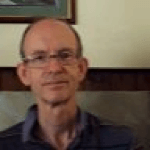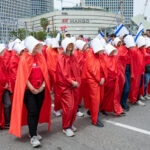Summary: In a recent interview, Tommie Smith spoke of his early life, his historic protest with John Carlos at the Mexico City Olympic Games in 1968, and its consequences. Here, a link to the article, and a reprint of what Marxist-Humanists wrote about it at the time – Editors.
Priti Patel, Home Secretary in Boris Johnson’s government and an arch reactionary in British politics, criticised sports people who “take the knee” against racism, dismissing it as “gesture politics”.
What she does not realise is that a gesture can be incredibly powerful, and even resonate down the decades. It can also require great personal courage and sacrifice, as shown in this interview with Tommie Smith who, with John Carlos, gave the raised fist salute at the 1968 Olympics in Mexico City. Both feared for their lives at the time, and lost their careers in athletics.
Here is what Marxist-Humanists wrote about it at the time, from News & Letters, November 1968 (Volume 13, number 9). The article was not signed.
Black Olympic Protest
The silent protest by Tommie Smith and John Carlos at the Mexico City Olympics showed the whole world the determination of black people to be free of American racism. When Avery Brundage, U.S. Olympic Committee Chairman first suspended Smith and Carlos, and then—at the urging of the State Department—gave them 48 hours to leave Mexico, many U.S. athletes, white and black, offered to walk out, but Smith and Carlos urged them to stay and protest. One white athlete, Australia’s Peter Norman, on the victory stand with them, wore a button of support. Black athletes seemed inspired to make literally superhuman efforts to win their events in order to have the opportunity to protest on the victory stand in their own way. Some wore black berets, some black socks, and one accepted his award barefooted. The protests for freedom at the Olympics were not limited to black Americans. The Czechoslovak Women’s Gymnastic champion twice refused to look at the Russian flag as it was raised and instead bowed her head in mourning over the invasion. Asked if she was going to defect to the West, she answered that she was returning to her country to present her medals to Dubcek and Svoboda as a gesture of her support. The Olympic big-shots, worried at the meetings between American black athletes and Africans, and the display of a world in revolt in their midst, decided to limit the march during the final ceremonies to only six hand-picked members of each team. Their efforts were in vain, however, as athletes from many countries broke through police lines to join their brothers and sisters in the arena in a final gesture of solidarity. In contrast to Brundage’s racism and hypocrisy, the protesting athletes showed the world what the Olympics were supposed to mean — human brotherhood.
LEAVE A REPLY
1 Comment
LEAVE A REPLY
1 Comment
 Paul Rubner on October 25, 2021 at 9:40 pm
Paul Rubner on October 25, 2021 at 9:40 pmWhile not wishing to detract from the significance of the protest by Smith and Carlos , it is noteworthy that the third man in the picture is Peter Norman, a white Australian athlete who won silver in the event. On his left breast Norman wore a small badge that read: “Olympic Project for Human Rights” — an organisation set up a year previously opposed to racism in sport, stood in solidarity with Smith and Carlos.
Like Smith and Carlos, Norman’s career in athletics was made to end because of the protest.






While not wishing to detract from the significance of the protest by Smith and Carlos , it is noteworthy that the third man in the picture is Peter Norman, a white Australian athlete who won silver in the event. On his left breast Norman wore a small badge that read: “Olympic Project for Human Rights” — an organisation set up a year previously opposed to racism in sport, stood in solidarity with Smith and Carlos.
Like Smith and Carlos, Norman’s career in athletics was made to end because of the protest.